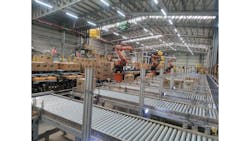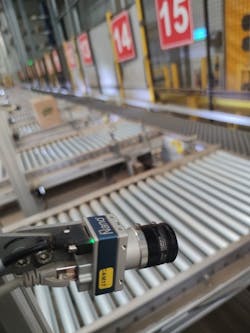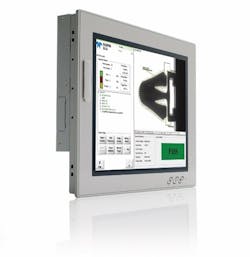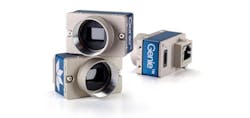Automated food packaging system uses vision systems to read/inspect packages for palletization
Food processing and packaging operations can be massive. Unilever (London, United Kingdom; www.unilever.com) enlisted Kibele-PIMS (İzmir & İstanbul, Turkey; www.kibele-pims.com) to automate the palletization and packaging processes within the Knorr (Heilbronn, Germany; www.knorr.com) and Lipton (Bruxelles, Belgium; www.lipton.com) production facilities in Besan, Turkey. Unilever needed a vision system to transition from a manual sorting system and to read, inspect, and send food packages to the correct lines for palletization. The overall automation system includes the machine vision systems on the lines as well as robots for palletization. Kibele-PIMS turned to Teledyne DALSA (Waterloo, ON, Canada; www.teledynedalsa.com) for the vision system.
According to Erdal Başaraner, Managing Director at Kibele-PIMS, the company solved the problem in two stages, with palletization being the second stage. He adds that the vision systems employed at these locations allowed Kibele-PIMS to join the robotics and vision control system together.
The Knorr and the Lipton lines, Başaraner explains, needed “eyes.” He states that the robots’ jobs are straightforward in terms of their tasks, but it is not as straightforward when packages come down the lines. Some packages might be damaged, or a misread QR code could send the package down the wrong line. The vision systems, in this case, employed Teledyne DALSA Genie Nano M1920 area cameras with GEVA 312T industrial imaging processing PCs. The cameras use Teledyne DALSA’s Sherlock programming language whenever they need to communicate with other products via a PLC, in this case a Beckhoff )Verl, Germany; www.beckhoff.com) PLC.
Related: Machine vision system ensure accurate Girl Scout cookie shipments
For Knorr, Kibele-PIMS built a system using 19 Genie Nano M1920 cameras, four GEVA 312T workstations, and three KUKA (Augsburg, Germany; www.kuka.com) robots working on a 27-meter linear axis. The Lipton line features 10 lines, five Universal Robots (Odense, Denmark; www.universal-robots.com) (UR10s), 12 Genie Nano M1920 cameras, and three GEVA 312T workstations. For Knorr, the system’s mission is to classify the types of soup, sauces, and other company products packaged in small batches that come from production via a 27-m feeding conveyor and transfer the identified product types to the correct packaging station. At the beginning of each packaging station (Figure 1), a camera reads QR Codes on the boxes to classify the product and assign it to the correct conveyor belt. At the same time, the camera checks incoming boxes for possible damage to the packaging. Defective cardboard boxes stay on the feeding conveyor belt until the end, where plant personnel manually inspect the boxes to determine if they need to be repacked.
On the Knorr line, a box arrives at one of 17 stations where the three KUKA robots installed on linear axes place them on pallets. The completed pallets move past two additional cameras used to record the number of pallets, expiration dates, and the type of product. This information goes to a labeling machine that prints the associated transport labels, attaches them to the pallets, and releases them for shipment. Additionally, the system transfers this information to an ERP system.
Kibele-PIMS chose the Genie Nano M1920 cameras (Figure 2) used for machine vision systems on the Knorr and Lipton lines because they met all the resolution and speed requirements Unilever specified. Additionally, Kibele-PIMS has a 15-year relationship with Teledyne DALSA and has been pleased with the cameras’ durability and performance. The monochrome area scan cameras are part of Teledyne DALSA’s Genie Nano camera line, a CMOS GigE camera line that features CMOS sensors and proprietary camera technology. The camera line includes mono, color, and NIR response models and C, CS, and F-mount lens mounts. Teledyne DALSA's proprietary TurboDrive™ technology allows Genie Nano to deliver its full image quality at fast frame rates with no changes to a GigE network. The cameras are 44 x 29 x 21 mm in size, feature the Sony IMX249 image sensor, 2.4-MPixel resolution, GigE interface, 5.86-µm pixel size, and 38.8-fps image capture.
The Knorr line has four GEVA 312T industrial image processing PCs (the Lipton line has three) equipped with Sherlock vision application software specifically designed to simplify the design and deployment of automated inspection on the factory floor. The GEVA-312T (Figure 3) is an integrated vision system that includes a 12-inch touch screen display, a 1.6-GHz dual-core processor, and two Gigabit Ethernet camera ports. Its form factor allows for PLCs, motion controllers, and non-vision-related components at the control panel. It is compatible with the full range of Genie cameras. Applications using one or two cameras can connect directly to the Camera/LAN ports on the unit. It can accommodate additional cameras using standard, low-cost Gigabit Ethernet switches. Interface I/O connections, including camera trigger and light strobes, use a standard PL-USB module. This module mounts inside the control panel and connects to one of the GEVA-312T USB ports (multiple PL-USB modules can be installed).
Related: Machine vision system employs novel deep learning software
The GEVA-312T units evaluate all the images. On the Knorr line, three PCs evaluate images from 17 cameras in the feeding conveyor, and the fourth one calculates the data from the two cameras at the end of the Knorr line. The systems’ touchscreens allow operators to use them as graphical user interfaces (GUIs). Additionally, Kibele-PIMS saves the data on the products and pallets on the GEVA PCs and can generate a wide variety of reports to pass along to customers.
Sherlock is an advanced machine vision software interface that can be applied to a wide variety of automated inspection applications. It offers design flexibility and provides a suite of tools and capabilities that have been deployed in thousands of installations worldwide.
Installation was not without its challenges, none the least of which was assembling the entire systems at Kibele-PIMS’s facilities prior to assembling them at Unilever. Basically, Kibele-PIMS assembled everything, according to Başaraner, then disassembled and brought everything to the Unilever factory. Additionally, Kibele-PIMS had to wait for Unilever to go on a 14-day break so the facility was empty. Work at the Unilever plant goes on continuously, so Kibele-PIMS needed a time when all the lines shut down. Başaraner says this is typical for food factories and vehicle production lines because these types of companies cannot afford to stop the lines. This stoppage normally occurs at the end of the year, so the temperature is also quite cold, another challenge.
In addition, there were technical challenges. The main challenge was to prepare a level ground for the linear axis to work smoothly on. For this purpose, before placing the linear axis and the robots, the ground on the site had to be levelled.
As with any vision system installation, lighting is key, and Kibele set up custom illumination for different purposes. QR code reading required one type, and for package inspection it set up other special-purpose illumination. The environments at the Unilever facilities featured continually changing lighting conditions. “Whenever there is visual inspection,” says Başaraner, “there must be special lighting. The ideal condition, contrary to what many people think, is actually complete darkness and our artificial light. We don’t like daylight.”
Başaraner adds that because the standard environmental light conditions are not stable, there could be scenarios where the cameras might not read the QR codes, leading to the cases ending up on the wrong pallets. Installing the lights did not involve any serious challenges.
Switching to the fully automated solutions at the facility has increased profitability and decreased the number of errors in correctly packaging the food. In the new setup, boxes arrive every 1.5 seconds on average on the Knorr line and every 2 seconds on the Lipton line.
About the Author
Chris Mc Loone
Editor in Chief
Former Editor in Chief Chris Mc Loone joined the Vision Systems Design team as editor in chief in 2021. Chris has been in B2B media for over 25 years. During his tenure at VSD, he covered machine vision and imaging from numerous angles, including application stories, technology trends, industry news, market updates, and new products.





